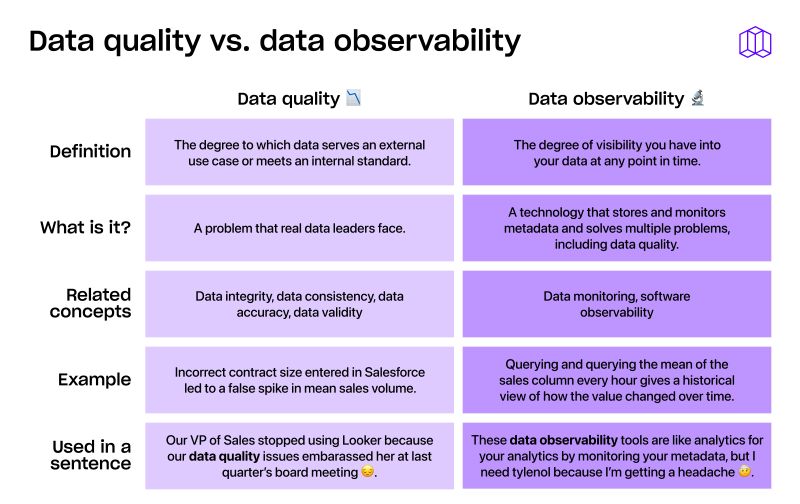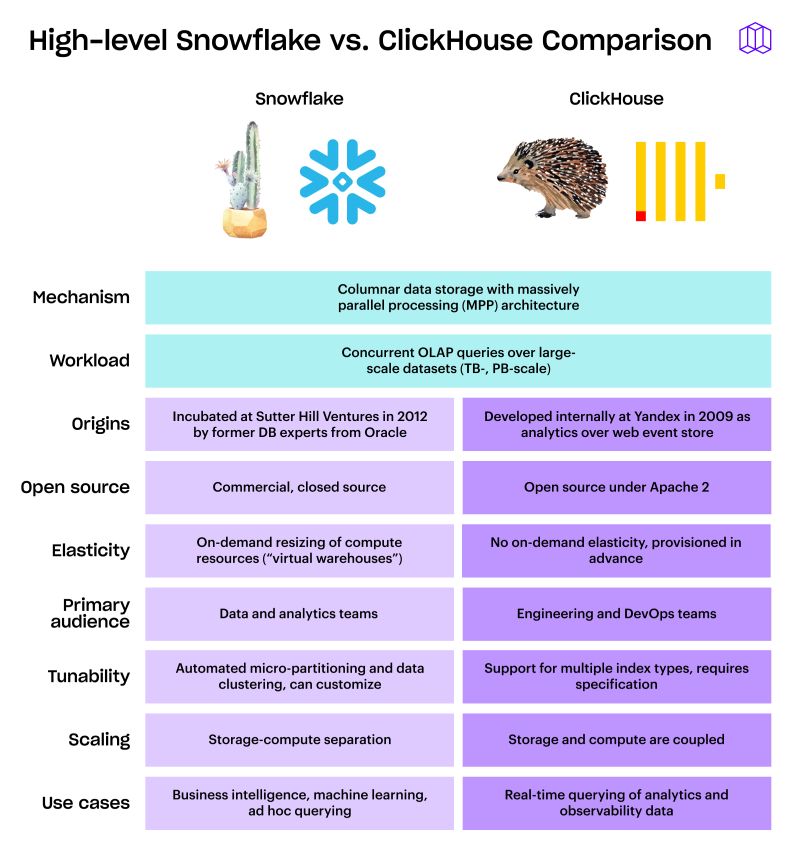Data anomalies: Definition, examples, and best practices for finding and resolving them
Data anomalies can be a result of natural causes, or they could mean that something in your pipeline is seriously broken. Read on to learn all about data anomalies, how they impact your pipeline, and tips for finding and resolving them.

You've been there before: staring at a dashboard that suddenly looks off, fielding Slack messages about missing data, or worse—presenting numbers to leadership that turn out to be completely wrong.
When left undetected, data anomalies can undermine trust in your data, lead to poor business decisions, and leave your team scrambling to explain what went wrong.
In this guide, we'll dive into everything you need to know about data anomalies: what they are, how to spot them, and most importantly—how to tackle them before they create downstream chaos for your organization.
What are data anomalies?
Simply put, a data anomaly is an observation that deviates significantly from the expected pattern in your dataset. It’s the unusual spike in a consistently stable metric, the sudden drop in daily active users, or the unexpected null values appearing in a critical field. These anomalies are often identified as data points that deviate from standard patterns, indicating potential issues or unique trends that warrant attention.
But there’s an important distinction to make: not all outliers are anomalies, and not all anomalies are errors.
- Outliers are extreme values that may still be valid data points
- Errors are incorrect values resulting from system failures, bugs, or human mistakes
- Anomalies are unexpected patterns that could be either valid outliers or actual errors—the key is that they require investigation
We'll get into the reasons anomalies occur and the business impact they can have, but first, let's cover the most common types of data anomalies.
Common types of data anomalies
Understanding the various types of anomalies is the first step in developing effective detection strategies. Let’s explore the main categories you’re likely to encounter:
Incorporating various anomaly detection techniques is crucial for identifying data outliers and maintaining data quality and integrity.
1. Point anomalies (aka spike or drop anomalies)
Point anomalies are single data points that deviate sharply from all others, appearing as sudden spikes or dips in a time series. They typically indicate one-off events or errors—such as a glitch, a rare event, or a data pipeline issue—that cause a value to jump far outside the normal range. These are usually straightforward to detect because the point clearly breaks the expected pattern.

Example: If an ETL job normally loads ~100,000 rows into a database daily but one day ingests 500,000 due to a duplicate run, that one-day surge is a point anomaly.
2. Contextual anomalies
Contextual anomalies are data points that are unusual in a specific context (such as time of day, day of week, or season) even if they might be normal in a broader sense. Context provides the baseline expectation, so a point becomes anomalous only when compared to others in its context (e.g. this Monday’s value against typical Mondays).

Example: A 30% drop in website traffic might not be alarming on a major holiday (when low activity is expected), but the same 30% drop on a normal Tuesday would be flagged as a contextual anomaly.
3. Collective anomalies
Collective anomalies are patterns where a group of data points is anomalous together, even if each point looks normal in isolation. This type of anomaly emerges from a sequence or cluster of values that deviates as a whole from the expected behavior. Often it indicates a sustained issue or a systemic shift affecting multiple data points in a row—something you’d miss if you only examined individual points.

Example: If a data pipeline delivers slightly fewer records each day for a week (around a 5% drop daily), no single day’s drop stands out by itself. But over the week, that persistent downward pattern forms a collective anomaly, signaling a broader problem in the pipeline.
4. Trend shift anomalies
Trend shift anomalies occur when the underlying trend or baseline of the data changes abruptly, creating a new normal. In these cases, the time series doesn’t just spike and return to old levels; instead, it jumps to a higher or lower range (or changes its growth rate) and stays there going forward. These shifts can happen after major events or changes—like a feature launch, a policy change, or a pipeline update—that permanently alter the metric’s behavior.

Example: A mobile app might average ~50,000 daily users and then jump to ~70,000 after a big marketing push, never dropping back to the old level. That lasting increase establishes a new baseline—a clear trend shift in user engagement.
5. Seasonal change anomalies
Seasonality change anomalies happen when the normal repeating pattern in a time series (daily, weekly, or annual cycles) alters unexpectedly. Many metrics have predictable cycles (for instance, an app might see weekday vs. weekend usage differences or an e-commerce business sees holiday-season spikes).

Example: If a streaming platform typically sees a surge in traffic every Saturday night but suddenly the peak shifts to midweek, that break in the weekly pattern is a seasonality change anomaly in user behavior.
Causes of data anomalies
Data anomalies can arise from a multitude of sources, each presenting unique challenges for data integrity. Understanding these causes is the first step in addressing data quality issues effectively.
- Human error: Simple mistakes like fat fingering an extra zero and turning a $100 transaction into a $10,000 one.
- System malfunctions: Technical glitches, software bugs, or hardware failures can disrupt data collection and processing, leading to anomalies. A server crash during data upload, for example.
- Data integration issues: Merging data sets with different formatting—like MM/DD/YYYY vs. DD/MM/YYYY can lead to misaligned records and create anomalies.
- Data quality issues: Poor data quality can lead to anomalies. Duplicate entries in a customer database, for example, can inflate user counts and distort metrics.
- External factors: Changes in external factors like market trends or weather patterns can cause unexpected data patterns. A sudden market shift might lead to an unusual spike in sales data, which could be mistaken for an anomaly.
- Data corruption: Data corruption due to transmission errors, storage issues, or malware can result in anomalies. Corrupted files might contain unreadable or nonsensical data, disrupting analysis.
- Sampling errors: Biased or incomplete sampling can lead to anomalies. If a survey only includes responses from a specific demographic, the results may not accurately represent the broader population.
- Measurement errors: Inaccurate or imprecise measurements can cause anomalies. Faulty sensors in an IoT system might report incorrect temperature readings, affecting data reliability.
Addressing these causes is essential for ensuring data quality and maintaining the integrity of your data analysis.
The cost of undetected data anomalies
We've all been there: a stakeholder points out a discrepancy in a report, and suddenly everyone questions the validity of your data. The tangible and intangible costs add up quickly:
- Direct financial impact: Bad data leads to bad decisions that can cost real money
- Wasted resources: Data teams spend valuable time firefighting instead of building
- Eroded trust: Once stakeholders lose faith in your data, rebuilding that trust can take months
- Missed opportunities: When teams don't trust the data, they stop using it to make decisions
The reality is that data anomalies aren't just a technical problem—they're a business problem.
We've gone from stakeholders reporting data issues weeks after being found to (our team) flagging the person that matters.
— Julie Beynon, Head of Analytics at Clearbit
In a data-driven organization, the health of your data directly impacts the health of your business. That's why investing in anomaly detection isn't a nice-to-have—it's essential.
Methods for detecting data anomalies
Let's get practical and explore how you can spot these pesky anomalies before they wreak havoc on your dashboards and reports.
Statistical methods
Traditional statistical approaches provide a solid foundation for identifying data points that deviate significantly from the norm.
Key statistical techniques you should know:
- Z-scores: Flag values that are multiple standard deviations from the mean
- Interquartile Range (IQR): Identify values outside 1.5 times the IQR
- DBSCAN: Density-based clustering to identify outliers
The catch? These methods tend to struggle when your data gets complex or has seasonal patterns. That's where more sophisticated approaches come into play.
Machine learning
As your data infrastructure grows, the complexity of your data patterns often grows with it. When simple statistical methods start to falter, machine learning offers more sophisticated detection capabilities.
Isolation Forests efficiently isolate outliers through random partitioning, making them computationally friendly even for large datasets.
ML approaches worth exploring:
- Autoencoders: Neural networks that learn to reconstruct normal data patterns
- One-class SVM: Maps data to a high-dimensional space to detect anomalies
- LSTM Networks: Particularly effective for time-series data where temporal patterns matter
The real advantage of ML approaches is their adaptability—they can evolve as your data patterns change and handle multi-dimensional data that would overwhelm simpler methods.
Time series analysis
Most data engineering work involves time in some way, and time-based anomalies can be particularly tricky to spot. For data with temporal patterns, specialized approaches yield better results.
Powerful time series tools:
- ARIMA Models: Forecast expected values and flag significant deviations
- Prophet: Facebook's tool that handles seasonal effects and holiday impacts
- Exponential Smoothing: Weights recent observations more heavily
These approaches really shine when you're monitoring metrics that follow regular cycles or seasonal patterns—like e-commerce sales, website traffic, or recurring business processes.
Visualization techniques
Never underestimate how much a good visual can reveal. Sometimes, the patterns that algorithms miss are immediately obvious to the human eye.
Visualization methods that cut through the noise:
- Box plots quickly identify outliers in distributions
- Heat maps help spot unusual patterns in multi-dimensional data
- Control charts monitor processes over time with statistical control limits
A data pattern that might look anomalous to an algorithm could be perfectly explainable to someone who understands the business context.
Best practices for data anomaly detection
Now that we've covered the methods, let's talk about building an effective anomaly detection system. Here are some best practices for your data team to follow.
1. Establish meaningful baselines
You can't identify anomalies without first understanding what "normal" looks like for your data. This foundation step is crucial but often rushed.
Start by analyzing historical patterns over different time frames—daily, weekly, monthly—to get a complete picture of your data's natural rhythms. Make sure to account for expected variations like seasonality or business cycles that might otherwise trigger false alarms.
Quick tip: Create segment-specific baselines when appropriate. Your e-commerce order data might need different baselines for weekdays versus weekends, or for different product categories.
2. Automate monitoring across your data stack
Manual checks don't scale very well, and they're the first thing to slip when you're busy putting out fires elsewhere. To keep up, it's best to use an automated monitoring tool.
What to monitor throughout your pipeline:
- Raw inputs (Are your source systems sending data correctly?)
- Transformed data (Did your ETL processes run successfully?)
- Final outputs (Do your dashboards have the right numbers?)
- Include freshness, volume, schema, and distribution checks
A smart approach is to prioritize your most critical data assets first, then gradually expand coverage as you refine your monitoring rules. This focused approach prevents alert fatigue while ensuring your most important data gets the attention it deserves.
3. Implement intelligent thresholds
Fixed thresholds are a recipe for headaches—they'll either miss real anomalies or flood you with false positives. I've seen teams spend more time tuning thresholds than actually fixing data issues.
Instead, use adaptive thresholds that adjust to data patterns over time. Apply different rules for different data contexts—what's normal for your high-volume product lines might be anomalous for niche categories.
Adaptive threshold approaches:
- Percentage-based deviations that scale with your data
- Moving window calculations that adjust to recent patterns
- Machine learning models that learn normal behavior over time
The goal isn't perfection, but a balance that catches important issues without overwhelming your team with noise.
4. Create alert hierarchies
Not all anomalies deserve the same level of attention. It's best to create a tiered alert system so that your team isn't rushing to their computer on a Friday night for a non-urgent issue.
Develop a tiered alert system:
- Critical: Business-impacting issues requiring immediate attention
- Warning: Potential issues that should be investigated soon
- Informational: Unusual patterns worth noting but not alarming
Set different notification channels based on urgency—Slack for critical issues that need immediate attention, email for less urgent ones, and maybe just logging for informational anomalies. This prevents alert fatigue and ensures the right people see the right issues at the right time.
5. Document expected anomalies
Sometimes what looks like an anomaly is actually an expected variation. Maintaining a calendar of marketing campaigns, product launches, and other business events can prevent false alarms when these activities impact your data.
With Metaplane, you can actually train our ML model by giving it feedback on each alert and letting it know if an anomaly is actually an expected variation.

6. Schedule regular reviews and refinement
Your data patterns evolve, and so should your detection systems. Schedule regular reviews of alert patterns to identify which ones are providing value and which ones are just adding noise.
Remember, perfect detection is an ongoing journey, not a destination. The goal is continuous improvement, not perfection from day one.
Resolving data anomalies—step by step
You've detected an anomaly—now what? Here's a tactical approach to efficiently resolve data anomalies when they pop up:
1. Validate the anomaly
First, determine if you're dealing with a real issue or just a false alarm.
Validation checklist:
- Does the anomaly persist across different time frames?
- Can you verify it with alternative data sources?
- Have you ruled out known system changes or business events?
I've seen teams waste hours investigating "anomalies" that were actually the result of planned maintenance or a successful marketing campaign that no one documented.
2. Perform root cause analysis
Once validated, dig into the why. Trace the data lineage upstream to identify the source—most anomalies originate earlier in the pipeline than where they're first detected.
The key here is systematic investigation rather than random guessing. Work backward from the symptom to the cause using your knowledge of the data architecture.
Common root causes to investigate:
- Data source changes or outages
- ETL process failures or modifications
- Schema or business logic changes
- Infrastructure issues affecting data processing
With automated, column-level lineage across your entire data stack, Metaplane makes it easy to find the root cause of an issue, and see which assets were impacted down stream.
3. Implement immediate fixes
With the root cause identified, address the immediate impact. Apply data corrections if appropriate and possible, but be careful not to introduce new issues in the process.
Transparent communication with affected stakeholders is essential—let people know what happened, what you're doing about it, and when they can expect resolution. Document the issue and interim solution thoroughly so you can refer back to it if similar problems occur in the future.
Quick tip: Sometimes it's better to temporarily exclude anomalous data from critical reports than to make hasty corrections that might need to be reversed later.
4. Develop long-term solutions
Preventing the same issue from recurring is where the real value comes in.
Sustainable solutions to consider:
- Strengthen validation rules at data entry points
- Enhance monitoring for similar issues
- Update documentation and data dictionaries
- Add regression tests for the specific scenario
The best data engineers don't just put out fires—they make their systems more fire-resistant with each incident.
5. Communicate and learn
Close the loop with stakeholders and your team. Notify users when the issue is resolved so they can resume normal operations with confidence.
Conduct a postmortem to capture lessons learned—what went well, what could have gone better, and what you'll do differently next time. Update your anomaly detection rules based on the incident, and train team members on new patterns to watch for.
How Metaplane helps detect and resolve data anomalies
Detecting and resolving anomalies across a complex data stack is challenging. Here's how Metaplane makes this process simpler and more effective:
Automated anomaly detection that actually works
Metaplane automatically monitors your data for all types of anomalies without requiring complex setup.
Comprehensive monitoring coverage:
- Freshness monitors: Detect delays in data updates
- Volume monitors: Identify unexpected changes in row counts
- Schema monitors: Alert on structure changes
- Distribution monitors: Catch statistical shifts in your data
- Custom SQL monitors: Address your unique requirements
The real difference is in how these monitors work together to give you a complete picture of your data health.
ML-powered adaptive thresholds
One of the biggest headaches in anomaly detection is configuring and maintaining thresholds. Metaplane's machine learning algorithms learn your data's normal patterns automatically, so you don't have to guess what's "normal" for each metric.
These adaptive thresholds adjust to seasonality and trends in your data, reducing false positives while still catching real issues. This means less time spent tuning alerting rules and more time focused on actual data problems that need your attention.
Full data stack coverage
Metaplane integrates with your entire data ecosystem—from ingestion to end destination. This means you can monitor your entire data pipeline from a single tool, eliminating blind spots where issues might hide. Instead of cobbling together multiple monitoring solutions, you get one consistent view across your stack.

Root cause analysis made simple
When anomalies occur, Metaplane helps pinpoint the source instead of leaving you to play detective.
Troubleshooting accelerators:
- Lineage tracking to identify upstream dependencies
- Detailed context about when changes occurred
- Comparison views to understand exactly what changed
This dramatically reduces the time from detection to resolution—from hours of investigation to minutes of focused resolution.
Streamlined incident management
Resolving issues faster becomes possible with integrated workflows. Notifications through Slack, Teams, or email alert the right people at the right time.
The result is a more proactive approach to data quality—one that catches issues before they impact your stakeholders and gives you the tools to resolve them efficiently.
Using Metaplane feels like having another data team member dedicated to keeping up and watching every change.
— Jake Hannan, Sr. Manager, Data Platform at Sigma
Final thoughts
Data anomalies are inevitable in any data ecosystem, but their impact doesn't have to be devastating. With the right detection methods, processes, and tools, you can catch and resolve anomalies before they undermine trust in your data.
Ready to level up your data anomaly detection? Metaplane can help you automate this process, providing comprehensive coverage across your data stack with minimal setup and maintenance. Get started today and stop letting anomalies disrupt your data-driven decision making.
FAQ About Data Anomalies
What's the difference between an outlier and an anomaly?
Outliers are extreme values that may still be valid data points. Anomalies are unexpected patterns that require investigation and could be either valid outliers or actual errors.
How many anomalies are normal in a dataset?
This varies widely by domain and data type. In general, anomalies should be rare (typically <1% of observations), but this percentage can be higher in domains with natural volatility.
Can machine learning detect all types of anomalies?
While ML methods are powerful, they aren't perfect for all scenarios. They work best with sufficient training data and struggle with completely novel patterns. A hybrid approach combining statistical methods, ML, and domain knowledge usually works best.
How do I know if my anomaly detection system is working?
Effective systems should catch real issues while minimizing false positives. Track metrics like precision (percentage of true anomalies among flagged items), recall (percentage of total anomalies detected), and time-to-detection.
Should I remove all anomalies from my dataset?
Not necessarily. Some anomalies represent real and important events. Always investigate before removing data, and consider flagging rather than deleting anomalous values.
Table of contents
Tags
...

...



















